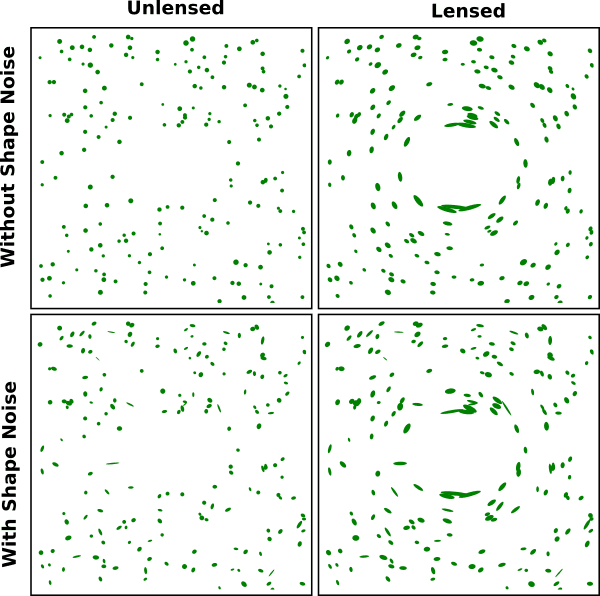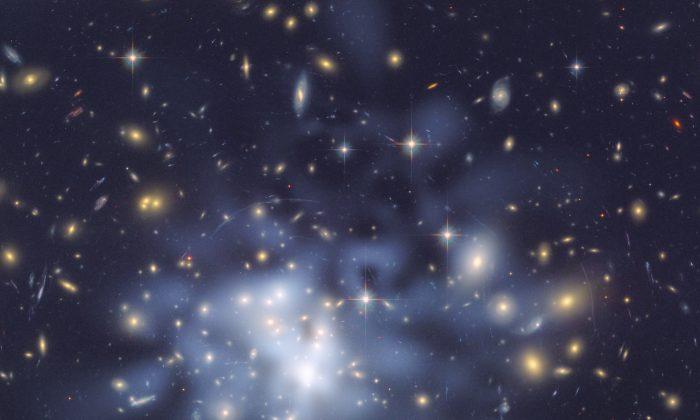Dark matter is the most common stuff in the universe. A billion sub-atomic particles of dark matter pass through your outstretched hand every second, yet few if any of these ethereal particles might actually touch and rebound from your hand in your lifetime. Now, studies are beginning to shed some light on this mysterious substance.
Astronomers have known since the 1930s that there is more than just the visible universe. The Milky Way, the galaxy we live in, is spinning too fast to be held together by the gravity between its stars. If stars were all there is, we should have long ago been flung off our cosmic roundabout. Instead, our galaxy contains about six times more material of some kind than is accounted for by every atom of all the elements in the periodic table: material known as dark matter.
Dark matter is invisible and can be detected only though the effect its gravity has on things we can see such as passing rays of light – an effect known as gravitational lensing. This is like looking through an uneven pane of glass which, while transparent, is obvious because of the distortions it produces on objects seen through it. By calculating the extent of the distortion, it’s possible to work out the thickness of the glass.
The recently released Dark Energy Survey used gravitational lensing to generate a huge map of dark matter. As seen from the Blanco telescope in Chile, they saw a crisscrossing web of thick, dark matter filaments.
The dark matter web is the invisible scaffolding that underpins the entire visible universe. The scaffold formed very soon after the big bang, and its gravity began to pull in all the ordinary material of which stars, planets and people are then built. Indeed, the galaxies are all found along dark matter filaments, with clusters of up to a thousand galaxies located wherever filaments cross each other.
So now we know where dark matter is. To find out what it is, we need the Hubble Space Telescope to zoom right in to the dark matter map.
Light vs Dark
On Earth we use particle accelerators to find out what matter is made of, firing particles at each other with enormous energy and seeing what the collision produces. This has been the principle behind experiments from Lord Rutherford’s discovery of atoms in 1908, to mankind’s biggest experiment, the Large Hadron Collider at CERN. But we can’t capture dark matter, nor interact with it at all. Nature, however, provides the experiment for us: we can watch what happens when the dark matter around galaxies or clusters of galaxies smash into each other by chance.
Galaxies are made from three ingredients: stars, dark matter and swirling clouds of gas. When two galaxies collide – an event involving expanses of time and space and size that makes it hard to comprehend – individual stars almost always pass straight unscathed. They are pinpoints of matter separated by vast regions of empty void. Conversely, the clouds of gas smash into each other and are pulled by friction to a stop. Dark matter is expected to behave somewhere in between, and its trajectory out of a collision should reveal its properties.

Astronomical Particle Colliders
In one well-studied collision known as the Bullet Cluster, dark matter appeared to whizz straight through the collision. As close as we can tell, dark matter kept pace with the stars, not measurably slowed by its ordeal. But interpreting only a single collision is difficult. We must reconstruct the 3D scene from just one viewpoint and one freeze-frame from a movie that lasts 100m years.
To crowd-source the full movie, we recently observed 72 high-speed collisions of the dark matter around galaxy clusters. We view some from the side, others head-on and each at a different stage in the crash. Reconstructing the statistical properties of a dark matter collision, we confirmed robustly that dark matter interacts very, very little with anything else.

The Dark Matter Drag Factor
Now we’ve also reported our observations of a 73rd collision. This involves individual galaxies, rather than clusters, which remain sufficiently intact for the immense gravitational forces to swing them around and throw them back into each other again. It makes for a very sensitive experiment. If invisible dark matter feels even a tiny amount of friction, it would eventually grow into a detectable lag behind the visible stars. Our collision itself is also nearer to Earth – and happens to take place perfectly in line with a gravitational lens, providing us the ideal viewing angle to track dark matter.
We found that the dark matter is indeed slightly offset from the stars. But while this is a more sensitive experiment than the cluster collisions, it’s also harder to interpret. The gas that originally accompanied the galaxy has slowed so much that it is long gone – and this removes one calibration point against which we could compare the behaviour of dark matter. Nor do we know the exact duration of the collision: an offset could be produced by a small amount of friction for a long time, or an even smaller amount of friction for a longer time.
Simulating Hypotheses
After such a long, messy collision, there might also be a more mundane explanation for the offset visible stars and dark matter. We can’t think of any yet, but Durham University’s Institute for Computational Cosmology runs the world’s biggest supercomputer simulations of dark matter. We’re teaming up with the Institute for Particle Physics Phenomenology in order to simulate millions of cluster collisions with different physics, to see if we can reproduce the observed offset in any other way.
The thought that dark matter might interact with, or respond to, forces other than gravity is tantalising – even a very small interaction is completely different to none at all. Once two particles of dark matter can interact, they need another type of particle (a force carrier) to interact through. At this point the bare bones of dark matter chemistry begins to emerge.
So for 80 years, scientists have suspected that an invisible, parallel dark universe exists around us, but remains elusive. Dark matter has always been described in terms of what it isn’t. With these experiments, we are for the first time describing dark matter for what it is.
[aolvideo src=“http://pshared.5min.com/Scripts/PlayerSeed.js?sid=1759&width=480&height=350&playList=518777170&responsive=false”]
This article was originally published on The Conversation. Read the original article.

Friends Read Free